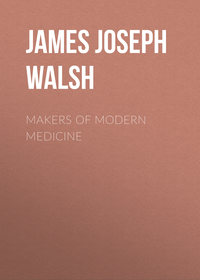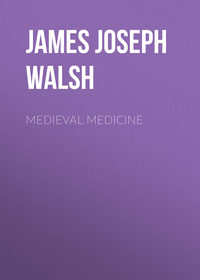 полная версия
полная версияPsychotherapy
It is not surprising that with such "facts" behind them the tractors attracted deep and wide attention. A contemporary tells of it and the fate of the inventor:
A gentleman in Virginia sold a plantation and took the pay for it in tractors. Nothing was more common than to sell horses and carriages to buy them. But the worst (or the best) of it was, yellow fever was raging in New York, and Perkins thought he could cure the fever with the tractors and fell a victim to the fever himself.
Success of Quackery.—Always in the history of quackery and, indeed, in the history of all therapeutics, the appeal is to the cures that have been effected. This is the only evidence, of course, that can be adduced for the development of therapeutics, and yet the history of medicine makes it clear how carefully supposed cures must be analyzed if they are really to mean anything. Mesmer could adduce thousands of cured cases. Perkins could do the same. Every quack in history, from Galen's weaver, who became a leech, down to the last street corner nostrum vendor, does the same thing. When on the strength of supposed cures, then, a new system of therapeutics is introduced, it is much more likely than not that there is no foundation for the claims made. We have had ever so many more experiences of disappointment after the introduction of remedies which cured at the beginning of their history, than we have had of remedies that maintain themselves after prolonged experience. It is the attitude of scepticism and suspended judgment until after a remedy or method of treatment has been tried on many different kinds of cases in varying circumstances that constitutes the only efficient safeguard against repeating the unfortunate errors of old times in the matter of drugs and remedial measures. If the public could be made to realize this, they would be much less easily taken in.
What the quacks cure are not always imaginary ills, but often ills that are very real, at least to the patients, and the symptoms of which are relieved by the confidence aroused in the new remedy and the representations of the supposed discoverer, who, in spite of the exaggerated claims which he makes, somehow succeeds in catching the trust of patients. Very often this process initiated by the quack is really only the beginning of the cure.
In most people a vicious circle of pathological subsidiary causes is formed when anything becomes the matter. Patients are persuaded that a serious illness is ahead of them. This keeps them from exercising as much as before. Becoming overcareful of their diet, they reduce it below the normal limit for healthy activity. This causes them to have less energy for work and disturbs their sleep. Then a host of minor symptoms, supposed to be due to the disease, whatever it is or they think it is, but really consequent upon the unhealthy habits that have formed, begin to develop. Just as soon as confidence in their power to regain health is restored to these people, a virtuous circle, to use the Latin word virtue in its etymological sense, of strength and courage, is formed. Everything conspires to stimulate the patients; they live more naturally, the subsidiary symptoms consequent upon their bad habits disappear and the disappearance of each one of them means for the patients a new assurance of triumph over disease. They attribute every improvement to the remedy they happen to be taking, though most of them are due to the changes in their habits, their diversion of mind, and the new energy released by their sense of encouragement.
An excellent example of how some of these mental persuasions in quackery act, and of how the cure is often really due to the physician who previously treated the case, though it is credited to the quack, may be found in the story that Hilton tells in his "Rest and Pain":
When this patient was first seen by a surgeon, he was thought to be laboring under some disease of the bladder and kidneys, for he had severe lumbago, pain over the bladder, and offensive urine. There had been no suspicion of anything wrong as regards the spine. He was a master painter and a house decorator, and was monstrously conceited, thinking himself right and everybody else wrong. When I explained to him, after careful examination, that the spine was the cause of the symptoms, he was not satisfied with my opinion and without my knowledge consulted Sir Benjamin Brodie, who also assured him that his spine was diseased and told him that he must rest it by lying down. To this he then assented. As he could not be controlled in his own house, I persuaded him to go to Guy's Hospital, where he had got nearly well; but he was very impatient, and would not remain long enough under my care to be quite cured. He returned home, gradually improved, and was getting quite well when some pseudo friend advised hydropathy and homeopathy—it did not matter which of the two—as "the thing" to cure him. After a few months he was perfectly restored, not by either hydropathy or homeopathy, but, no doubt, by nature. The man, however, feels convinced that hydropathy and homeopathy cured him. It so happens, gentlemen, that sometimes we do not get the degree of credit which perhaps belongs to us.
To Mr. Hilton's reflections one is tempted to add that many of these patients, after having been seriously ill, cannot bring themselves to think that they will gradually get well by the forces of nature. Even after they have improved very much they are still inclined to think that that improvement is illusory or will relapse because they have not been "cured," that is, actively treated, in some way so that a "cure" should result. When they are nearly well, because of properly directed rest and nursing, someone recommends some irregular form of treatment. They take it up and this gives them confidence that they are being cured. This state of mind makes the ultimate steps of their recovery more rapid than it otherwise would be. As a consequence, the irregular gets the credit. Immediately after this case Mr. Hilton tells the story of another case in which a "rubber" got all the credit for the cure. It is evident that the modern osteopath has only somewhat systematized what had been in existence generations ago.
All this tendency of human nature to respond to anything that is done for it, provided the promise of cure goes with it, is taken advantage of by the quack, sometimes unconsciously, for his own purposes. Results, as a rule, are secured, in spite of the remedies that he suggests, which in most cases do harm rather than good. Of the thousands of remedies that have been introduced by quacks, not one now remains, though every one of them produced wonderful cures on a great many patients at some time or other. It is the duty of the physician to secure just as good results honestly. He must influence the patient's mind favorably so as to bring about a modification of habits and a hopeful outlook on life, in spite of whatever ailment there may be. If he can do so he will have in his hands the best therapeutic measure that has been employed in all the history of medicine. It is the most universally applicable. It will cure, that is help, all forms of disease. It will relieve many of the symptoms of even incurable diseases. It will occasionally arouse the resistive vitality of the patient to such an extent that even apparently incurable diseases will be overcome. This is the lesson that the modern student of medicine must draw from the history of quackery.
CHAPTER VII
NOSTRUMS AND THE HEALING POWER OF SUGGESTION
A striking illustration of the power of the mind to bring about the cure of ailments and symptoms of every sort is found in the history of the many nostrums and remedies that have worked wonders for a time and later proved to be inert or even harmful. The ordinary definition of a nostrum includes the idea of secrecy. At all times in the world's history fortunes have been made out of such remedies. They appeal not only to the uneducated, but also to those who are supposed to be well informed, and this in spite of the fact that generally the remedies are claimed to do good for nearly every form of disease, and it must be evident to anyone, after a moment's serious thought, that the one idea of their inventor is not to benefit patients, but to make money.
With the multiplication of newspapers and magazines, there has been a great increase in these secret remedies and of their users. Apparently all that is needed for many people who are ailing, or think they are ailing, is to be told in a more or less impressive way that some remedy will cure, and then it proceeds to do them good. There is a general impression abroad that some of these remedies represent great discoveries in medicine, and the feeling of most of those who take them is that the inventor has found a new and wonderful remedy. During all the centuries such secret remedies have come and gone, and not one of them has proved to be of lasting value. Just as soon as its composition is no longer a secret it begins to fail. It is, therefore, evident that its effect was entirely due to influence on the mind and not at all to any influence on the body.
The stories of the origin of these remedies bear a striking similarity. There are two variants on the theme: either the inventor is supposed to be an earnest student of science, devoting himself to profound research for many years and finally finding some wonderful secret of nature hitherto hidden from men; or else the remedy has been discovered by happy accident, and some chronic sufferer pronounced by the most eminent physicians to be hopelessly incurable has in despair turned to the now method, caring little really, so discouraged is he, whether it does good or ill, and wakes up to find that he is on the high road to recovery, apparently having been directed by Providence in the use of the remedy in question. Overflowing with gratitude, he wants to share the heaven-sent blessing with all mankind—for a valuable consideration.
The Weapon Ointment.—Among the most famous nostrums, and a striking example of the great rôle played in therapeutics by mental influence and coincidence, is the Unguentum Armariam or Weapon Ointment. This famous remedy would cure any wound made by a weapon, if it could only be employed before the fatal effects were absolutely manifest. There was an abundance of evidence that it stopped the pain, checked the bleeding and initiated the restoration of the patient to health. We know the remedy not from traditions of its use among the uneducated, but from descriptions that we have by men who were among the best educated of their time, and that by no means an era of dullards. The story of this infallible remedy is all the more surprising because it was not applied to the wound itself, nor indeed to the sufferer at all, but to the weapon which inflicted the wound. Nay, it was well authenticated that, where the weapon could not be secured for inunction, if the ointment were applied to a wooden model of the weapon, the cure followed with almost, though, it was confessed by some, not quite so much assurance as in the fortunate case of the weapon being available.
The story has been so well told by Oliver Wendell Holmes in his "Medical Essays"8 that it seems best to retell it in abstracts from his "Homeopathy and Its Kindred Delusions." He says:
Fabricius Hildanus, whose name is familiar to every surgical scholar, and Lord Bacon, who frequently dipped a little into medicine, are my principal authorities for the few circumstances I shall mention regarding it. The Weapon Ointment was a preparation used for the healing of wounds, but instead of its being applied to them, the injured part was washed and bandaged, and the weapon with which the wound was inflicted was carefully anointed with the unguent. Empirics, ignorant barbers, and men of that sort are said to have especially employed it. Still there was not wanting some among the more respectable members of the medical profession who supported its claims. [Italics ours.] The composition of this ointment was complicated, in the different formulas given by different authorities; but some substances addressed to the imagination, rather than the wound or weapon, entered into all. Such were portions of mummy, of human blood and of moss from the skull of a thief hung in chains.
Hildanus was a wise and learned man, one of the best surgeons of his time. He was fully aware that a part of the real secret of the Unguentum Armarium consisted in the washing and bandaging the wound and then letting it alone. But he could not resist the solemn assertions respecting its efficacy; he gave way before the outcry of facts (!), and therefore, instead of denying all their pretensions, he admitted and tried to account for them upon supernatural grounds.
Holmes says further:
Lord Bacon speaks of the weapon ointment, in his Natural History, as having in its favor the testimony of men of credit, though, in his own language, he himself "as yet is not fully inclined to believe it." His remarks upon the asserted facts respecting it show a mixture of wise suspicion and partial belief. He does not like the precise directions given as to the circumstances under which the animals from which some of the materials were obtained were to be killed, for he thought it looked like a provision for an excuse in case of failure, by laying the fault to the omission of some of these circumstances. But he likes well that "they do not observe the confecting of the Ointment under any certain constellation; which is commonly the excuse of magical medicines, when they fail, that they were not made under a fit figure of heaven." It was pretended that if the offending weapon should not he had, it would serve the purpose to anoint a wooden one made like it. "This," says Lord Bacon, "I should doubt to be a device to keep this strange form of cure in request and use, because many times you cannot come by the weapon itself." And in closing his remarks on the statements of the advocates of the ointment, he says, "Lastly, it will cure a beast as well as a man, which I like best of all the rest, because it subjecteth the matter to an easy trial." It is worth remembering that more than 200 years ago, when an absurd and fantastic remedy was asserted to possess wonderful power, and when sensible persons ascribe its pretended influence to imagination, it was boldly answered that the cure took place when the wounded party did not know of the application made to the weapon, and even when the brute animal was the subject of the experiment, and that this assertion, lie as we all know it was, came in such a shape as to shake the incredulity of the keenest thinker of his time.
It is interesting to follow up some of the controversies among scientific men with regard to the weapon ointment, for they serve to show how the remedy came to maintain its prominence for so long. Podmore, in his "Mesmerism and Christian Science" (London, 1909), tells the story of the controversy between Goclenius, a professor of medicine at the University of Marburg, who published as the Inaugural Thesis for his professorship, a treatise on the "Weapon Salve," and Father Roberti, a Jesuit scientist and philosopher, whose final treatise in the controversy was entitled after the lengthy fashion of titles in that day, "Goclenius Corrected Out of His Own Mouth; or, The Downfall of the Magnetic Cure and the Weapon Salve." The decision of the controversy was eventually referred to the great physician of the time. Van Helmont, who decided that both disputants were partly wrong, the Jesuit erring most, but that above all Goclenius should distinguish between the cases when the weapon had blood on it and when it had not. When there is blood on the weapon, he held, then the salve is always effective; when there is not, then much stronger remedies were required. In both cases, of course, the salve or ointment was applied to the weapon.
In the midst of this discussion of the points at issue, it is interesting to note Van Helmont's opinion with regard to many curious things used in medicine at that time. He insists that Goclenius makes a mistake in attributing therapeutic power alone to the moss taken from the skull of a condemned criminal who had been hung in chains. This material, under the name of usnea, was apparently quite popular in prescriptions for various chronic ills, and especially those that we now recognize as prolonged neurotic affections. Van Helmont emphasizes the fact that the experience of all physicians shows that material taken from the heads of condemned criminals executed in other ways, as, for instance, those broken on the wheel, may be just as effective. Van Helmont conceived of the magnetic and sympathetic feeling as a natural process. All the force of the stars might be concentrated in objects that had been beneath their beams for a long time, and this might be communicated in some wonderful way to patients so as to supply defects of vitality. Such defects of vitality Van Helmont's prescriptions actually were compensating, but the source was in the patients themselves—that reservoir of surplus energy which remains unused unless some strong suggestion brings it out.
Sympathetic Powder.—After the weapon ointment, the best known of the nostrums of older times is probably Sir Kenelm Digby's famous Sympathetic Powder, which Dr. Holmes talks of as even better known than its great therapeutic predecessor. This, too, was a wonderworker. Unlike the Unguentum Armarium, however, its composition was simple. It was nothing else than copper sulphate which had been allowed to deliquesce to a white powder. This powder would cure any injury as infallibly as the weapon ointment. It, too, was not applied to the wound, but to the bloodstained garments (Van Helmont's distinctions between the bloody and the bright weapon should be recalled) of the wounded person. The patient did not need to be present at the time the application was made. He might be far away and yet its efficacy was, according to many very intelligent and highly educated persons, quite assured.
For the sympathetic powder we have one of the stories of far-fetched discovery that have since become so familiar. A missionary, traveling in the East, was said to have brought the recipe to Europe about the middle of the seventeenth century. The Grand Duke of Tuscany, in whose dominions the missionary took up his residence, heard of the cures performed by him and tried by offers of money and favor to obtain the missionary's secret, but without success. Sir Kenelm Digby, however, who was traveling in Italy, happened by good fortune to do a favor for the missionary, and put him under such deep obligations that he felt the only way he could properly repay his benefactor was to confide to him the composition of this wonderful remedy. Sir Kenelm Digby was at this time one of the best known of English scholars. After having reached distinction in the English navy, he had devoted himself to literature, to philosophy, and to politics. He had devoted much time to the old books of alchemy. Therefore, the offer of this precious piece of information especially appealed to him. On his return to England he proceeded to use it for the benefit of his friends, and it created a sensation. The French dictionary of the Medical Sciences tells the story of the application of the powder for the first time in England and of the subsequent use of it, especially on the nobility of England:
An opportunity soon presented itself to try the powers of the famous powder. A certain Mr. Howell, having been wounded in endeavoring to part two of his friends who were fighting a duel, submitted himself to a trial of the sympathetic powder. Four days after he received his wounds, Sir Kenelm dipped one of Mr. Howell's garters in a solution of the powder, and immediately, it is said, the wounds, which were very painful, grew easy, although the patient, who was conversing in a corner of the chamber, had not the least idea of what was doing with his garter. He then returned home leaving his garter in the hands of Sir Kenelm, who had hung it up to dry, when Mr. Howell sent his servant in a great hurry to tell him that his wounds were paining him horribly; the garter was therefore replaced in the solution of the Powder, and the patient got well after five or six days of its continued immersion.
King James I, his son, afterwards Charles I, the Duke of Buckingham, then Prime Minister, and all the principal personages of the time were cognizant of this fact; and James himself, being curious to know the secret of this remedy, asked it of Sir Kenelm, who revealed it to him, and his majesty had the opportunity of making several trials of its efficacy, which all succeeded in a surprising manner.
Tar Water and Therapeutic Faith.—One further story of an old nostrum deserves to be told because of the distinction of its chief promoter, who did not, however, as do most of the nostrum promoters, make a fortune by it. This is the incident of Bishop Berkeley and his tar water. Berkeley was one of the leaders of thought of the eighteenth century. At one time he came to America with the idea of enlightening the ignorance of the colonists and of founding a school of philosophy. Besides being one of the most learned men of his time, he was one of the best. He was known for his gentleness, his unselfishness, and his lack of pretension. Yet all of these virtues were unable to save him from falling a victim to a medical delusion. One of his essays is on the value of tar water in medicine, and is entitled "Siris, a Chain of Philosophical Reflections and Inquiries Concerning the Virtues of Tar Water," etc.
Tar water was prepared by stirring a gallon of water with a quart of tar, letting it stand for several days, and then pouring off the clear water. It, in fact, retained scarcely more of the tar than the odor. According to the great philosopher, this not only cured, but prevented diseases. The list is, indeed, so long that it is hard to understand how the claims for it could have received any credence. They did, however, and Berkeley himself, and many of his friends, were cured of many and various ills, and were protected from many more by its frequent use. The odor was the factor that proved of suggestive value and set free the springs of vital energy.
Sarsaparilla.—It might be thought that such deception of self and others as has been illustrated in the weapon salve and sympathetic powder would be impossible in our enlightened day. Anyone who thinks so forgets certain incidents of recent times. The story of sarsaparilla is a striking illustration. Few drugs have been more popular in the last half century, and it is even yet popularly supposed to be a wonderful tonic, a cure for many diseases. During the first half of the nineteenth century, when the humoral theory of the causation of diseases was generally accepted, certain German physicians thought they observed that a decoction of sarsaparilla was a sovereign remedy for various ailments having their origin in the blood. The blood was at that time supposed to become impure for many reasons, and the possibility of neutralizing such impurity by medical measures was seriously attempted. As Virchow used to insist, the humoral pathology still holds its ground in popular estimation, and so blood purifiers are favorite remedies, and will doubtless continue to be for at least another generation, until cellular pathology secures a hold on the popular mind.
Sarsaparilla came in, then, as a great blood purifier, and was used for ten years by many of the physicians of the world, confident that they were obtaining excellent results from its use. After a time, however, further study of the drug showed that it was inert. Gradually the employment of sarsaparilla as a remedial agent ceased, though it continued to be used as an elegant vehicle in the prescription of nauseating remedies.
Only after it had been thus abandoned by the regular profession, was it taken up extensively by others who advertised its virtues widely and secured a great clientele for it. Probably more money has been spent on sarsaparilla during the last fifty years than on any other single drug. Many millions were every year appropriated by rival concerns to advertise its virtues. It has been possible at any time during the last half century to secure any number of people who were willing and ready to declare—and most of them convinced of the truth of what they said—that various preparations of sarsaparilla had cured them of long-standing ills, and that they considered it a life-saving remedy.











